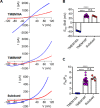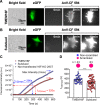Drosophila Subdued is a moonlighting transmembrane protein 16 (TMEM16) that transports ions and phospholipids
- PMID: 30700552
- PMCID: PMC6433057
- DOI: 10.1074/jbc.AC118.006530
Drosophila Subdued is a moonlighting transmembrane protein 16 (TMEM16) that transports ions and phospholipids
Abstract
Transmembrane protein 16 (TMEM16) family members play numerous important physiological roles, ranging from controlling membrane excitability and secretion to mediating blood coagulation and viral infection. These diverse functions are largely due to their distinct biophysical properties. Mammalian TMEM16A and TMEM16B are Ca2+-activated Cl- channels (CaCCs), whereas mammalian TMEM16F, fungal afTMEM16, and nhTMEM16 are moonlighting (multifunctional) proteins with both Ca2+-activated phospholipid scramblase (CaPLSase) and Ca2+-activated, nonselective ion channel (CAN) activities. To further understand the biological functions of the enigmatic TMEM16 proteins in different organisms, here, by combining an improved annexin V-based CaPLSase-imaging assay with inside-out patch clamp technique, we thoroughly characterized Subdued, a Drosophila TMEM16 ortholog. We show that Subdued is also a moonlighting transport protein with both CAN and CaPLSase activities. Using a TMEM16F-deficient HEK293T cell line to avoid strong interference from endogenous CaPLSases, our functional characterization and mutagenesis studies revealed that Subdued is a bona fide CaPLSase. Our finding that Subdued is a moonlighting TMEM16 expands our understanding of the molecular mechanisms of TMEM16 proteins and their evolution and physiology in both Drosophila and humans.
Keywords: Anoctamin; CaCC; Drosophila; TMEM16; calcium-binding protein; ion channel; membrane biophysics; membrane transport; phospholipid scramblase; protein moonlighting.
© 2019 Le et al.
Conflict of interest statement
The authors declare that they have no conflicts of interest with the contents of this article
Figures





Similar articles
-
Structure-Function of TMEM16 Ion Channels and Lipid Scramblases.Adv Exp Med Biol. 2021;1349:87-109. doi: 10.1007/978-981-16-4254-8_6. Adv Exp Med Biol. 2021. PMID: 35138612 Free PMC article.
-
Regulation of TMEM16A/ANO1 and TMEM16F/ANO6 ion currents and phospholipid scrambling by Ca2+ and plasma membrane lipid.J Physiol. 2018 Jan 15;596(2):217-229. doi: 10.1113/JP275175. Epub 2017 Dec 18. J Physiol. 2018. PMID: 29134661 Free PMC article.
-
An inner activation gate controls TMEM16F phospholipid scrambling.Nat Commun. 2019 Apr 23;10(1):1846. doi: 10.1038/s41467-019-09778-7. Nat Commun. 2019. PMID: 31015464 Free PMC article.
-
Structure and Function of Calcium-Activated Chloride Channels and Phospholipid Scramblases in the TMEM16 Family.Handb Exp Pharmacol. 2024;283:153-180. doi: 10.1007/164_2022_595. Handb Exp Pharmacol. 2024. PMID: 35792944 Review.
-
TMEM16 proteins: unknown structure and confusing functions.J Mol Biol. 2015 Jan 16;427(1):94-105. doi: 10.1016/j.jmb.2014.09.028. Epub 2014 Oct 17. J Mol Biol. 2015. PMID: 25451786 Free PMC article. Review.
Cited by
-
Electrophysiological Properties of Endogenous Single Ca2+ Activated Cl- Channels Induced by Local Ca2+ Entry in HEK293.Int J Mol Sci. 2021 Apr 30;22(9):4767. doi: 10.3390/ijms22094767. Int J Mol Sci. 2021. PMID: 33946319 Free PMC article.
-
TMEM16F scramblase regulates angiogenesis via endothelial intracellular signaling.J Cell Sci. 2024 Jul 15;137(14):jcs261566. doi: 10.1242/jcs.261566. Epub 2024 Jul 18. J Cell Sci. 2024. PMID: 38940198 Free PMC article.
-
Chloride-dependent mechanisms of multimodal sensory discrimination and nociceptive sensitization in Drosophila.Elife. 2023 Jan 23;12:e76863. doi: 10.7554/eLife.76863. Elife. 2023. PMID: 36688373 Free PMC article.
-
TMEM16 and OSCA/TMEM63 proteins share a conserved potential to permeate ions and phospholipids.Elife. 2024 Nov 4;13:RP96957. doi: 10.7554/eLife.96957. Elife. 2024. PMID: 39495104 Free PMC article.
-
Structure-Function of TMEM16 Ion Channels and Lipid Scramblases.Adv Exp Med Biol. 2021;1349:87-109. doi: 10.1007/978-981-16-4254-8_6. Adv Exp Med Biol. 2021. PMID: 35138612 Free PMC article.
References
Publication types
MeSH terms
Substances
Grants and funding
LinkOut - more resources
Full Text Sources
Molecular Biology Databases
Research Materials
Miscellaneous

